|
It’s safe to say that French director Jean Rollin is primarily known for his vampire movies, particularly their embracement of the eroticism that is inherent in a genre that too often tackles this aspect obliquely or metaphorically. It’s all part of that weird puritan attitude that seems fine with extreme violence but for some peculiar reason is outraged by sex and the naked human body. This has never been the case for Rollin, and it may well be that’s what first drew me to seek out his films, but when I finally saw one – and I do wish I could remember which one it was – it was not the nudity that struck me but the sly surrealism. This I wasn’t expecting, and as a long-standing devotee of this hugely influential art movement and particularly its cinematic manifestations, to encounter an erotic vampire movie with surrealistic elements was a bit of a thrill. One of the most celebrated of these surrealistic moments in all of Rollin’s filmography occurs 21 minutes into his remarkable third film, Le frisson des vampires, or as it translates to English, The Shiver of the Vampires. For those new to this title, let me set the scene.
Antoine (Jean-Marie Durand) and Isle (Sandra Julien) are newlyweds driving straight from their wedding to a planned honeymoon at an ageing countryside castle owned by Isle’s two cousins. When they reach the nearby village, however, a local woman named Isabelle (Nicole Nancel) informs them that both cousins passed away the previous day. They head on up to the castle anyway, where they are unemotionally greeted by two expressionless maids (Marie-Pierre Castel and Kuelan Herce), who have prepared a room for them regardless. Before they settle down for the night, Isle insists on visiting her cousins’ grave alone, but whilst paying her respects she is approached by Isabelle, who claims that she was a lover to both of the cousins and was soon to be married to them.
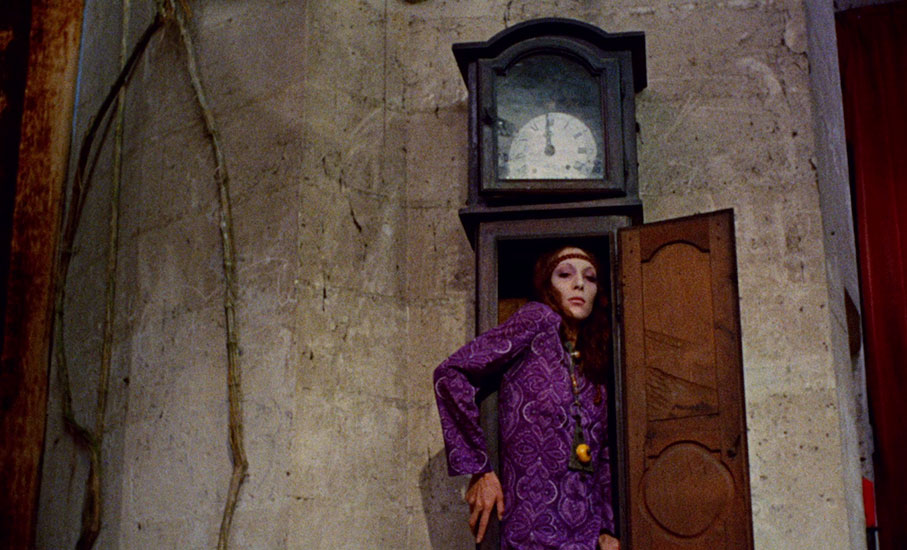
On her return to the castle, Isle tells Antoine that she is so upset by all of this that she would prefer to sleep alone tonight, and despite his obvious frustration, Antoine agrees and leaves her alone. Then it happens. As Isle disrobes in preparation for sleep, she hears a noise behind her and turns to see the door of a grandfather clock swing open, inside of which is wedged a statuesque woman (played by dancer Dominique), who steps out and slowly approaches Isle. Isle doesn’t scream or run away, but instead stares at the woman with a look of curious fascination before asking calmly, “Who are you?” The woman states that her name is Isolde, then slowly strokes and fondles the now naked Isle, who seems to rather like this attention. Isolde then drapes a black cape over Isle and leads her back out into the castle graveyard, where she disrobes her, kisses her like a lover, then sinks her vampiric teeth into her neck.
Before I go on, I should confess that the above synopsis did skip a few somewhat crucial details that are likely to affect how you read this scene, none of which is presented in what you might call a straightforward manner. You can start with the opening sequence of the cousins’ funeral, which plays out in black-and-white without a word of dialogue in tribute to the classic Universal horror movies that were Rollin’s first inspiration. Then there’s the post-title sequence, in which the two young women who later greet Antoine and Isle climb the stone spiral staircase of the castle tower that is bathed in a vivid red light. As they reach the top, they encounter two former vampire hunters who have been chained up and bitten, and have chosen death as preferable to spending eternity as vampires by driving stakes through their own hearts. Before expiring, one of them tells the women that to save their own lives – and potentially also his soul – they should take the stake he is about to plunge into his chest and use it to destroy the creatures of the night that consigned him and his companion to their current fate. If the women are unable to complete the task in time, he warns, then they should agree to serve the creatures, as that way their lives will be spared. The two women do as instructed, but when they reach the graveyard, the vampire Isolde has risen and is waiting for them. It’s then that we hop forward to the following morning and are introduced to Antoine and Isle as they drive to the castle, still dressed in their wedding attire. Yet despite all of this and an eye-popping use of coloured lighting, I still did a serious double-take the first time I watched Isolde step out of that clock. I probably shouldn’t have, given Rollin’s fondness for that particularly timepiece and the even more peculiar use he later put it to in his 2002 La fiancée de Dracula, where it’s used by Dracula as a matter transporter. I kid you not.
When Antoine realises that Isle is no longer in her room, he sneaks out to investigate, silently following the maids as they don translucent blue robes and enter what looks like a Satanic chapel. Here they calmly proceed to hammer a stake into the heart of a young woman who is laid on the alter in a crucified pose. Hiding their faces in their hand from this spectacle are two as-yet unidentified men (Michel Delahaye and Jacques Robiolles), who have blood on their lips and insist the woman’s death was necessary to avoid passing on the terrible curse with which they now live. “She should never have entered this sinister vault,” one of them states. “Our evil should not be propagated.” The next morning, the maids assure Isle that, contrary to what she may have heard, her cousins are not dead after all but are currently working in the library and will join them later. When they do so that evening, however, Antoine instantly recognises them as the men he observed in the vault the previous evening.
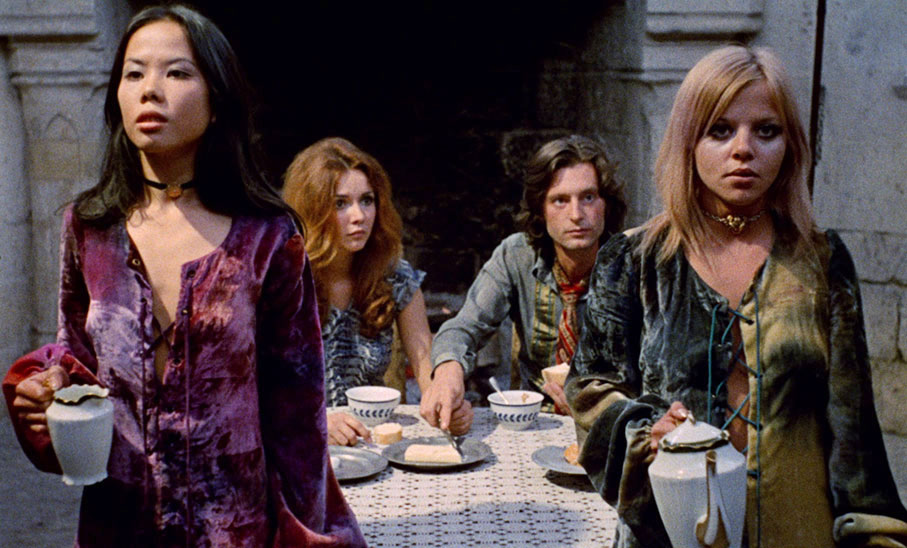
A far from complex plot is nonetheless intriguingly spun, with nothing overstated and the viewer encouraged to piece together the narrative building blocks from what we see and hear, and they bring to the film from their previous experience of vampire cinema. Rollin knows his vampire lore and plays with it here in interesting ways, something evident from the start in the notion of two vampire hunters that have fallen victim to their intended prey and who turn their weapons of vampire extinction on themselves. Seriously, how many times have you seen that in a genre movie? Then there are the two male vampires, who having fed off their victim insist that she be staked to prevent their cursed condition from spreading, a task they simply cannot face carrying out themselves or even witnessing. Here, traditional genre gender roles are reversed, with a female head vampire who has bitten and effectively entrapped two males, making a home for herself in their castle with the aim of feeding off and transforming visitors or wayward locals. The two maids, meanwhile, have clearly taken the advice of the vampire hunter and obey the every whim of their three new masters, at nightfall covering every crucifix the graveyard to allow Isolde safe passage from the tomb in which she rests inside her coffin during the daylight hours.
Also kicking against the genre standard of the day is an audio-visual presentation that, even over a half-a-century later, is quite unlike anything else the genre has offered up. Taking his cue from a proposal made by Rollin to project funder Monique Natan, cinematographer Jean-Jacques Renon gels his lights to bathe whole areas and even entire shots in vivid reds and blues, symbolically the colours of blood and moonlit night and contrasting strikingly with the often glummer interiors. This brings a semi-psychedelic edge to the imagery, in some ways reflecting the counterculture movement of the day, which is further echoed in the costumes of the vampires, whose hippie commune dress sense is neatly augmented by the tie-dyed colours worn by their two maids. Cementing the connection is the music by teenage rock group Acanthus, which kicks sharply against the orchestral norm with a prog-rock score that, as others have already noted, anticipates Goblin’s score for Dario Argento’s 1975 giallo, Deep Red, and even has a whiff of early Mike Oldfield about it. All combined, this helps to give the film the feel of a vampiric acid trip, making The Shiver of the Vampires the hippiest vampire movie in the genre’s long history. The rule-breaking extends in places to Rollin’s camera direction, with slow, circular pans that run for longer than theoretically required as they follow the walking maids as they become intermittently visible through tower windows, and which scan rooms for disconcerting artefacts or the faces of characters, who have to pause until the camera settles on them before delivering their lines. Elsewhere, the two male vampires lean alternatively into shot to deliver their lines, play with rhythmically with nearby props, or circle the room delivering dialogue to camera as if performing in a literary performance art piece devised by Alan Ginsberg. While a tad artificial, this combines with the prime colour-soaked exteriors, the trippy rock soundtrack, and the beatnik fashions to create a sense of an LSD-assisted waking dream. And just waiut until you see how Isolde kills a woman who she regards as a potentially problematic nuisance.
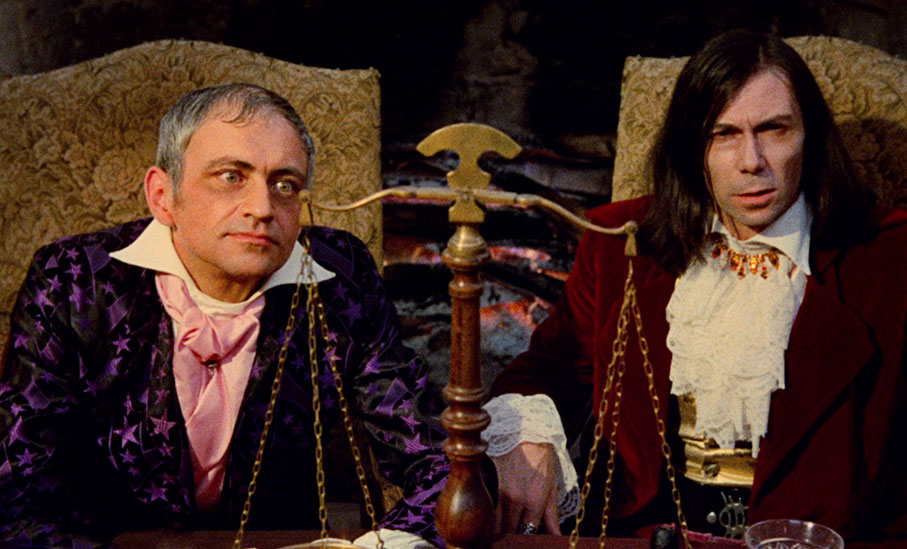
The two unnamed cousins are a rare example of male vampires in what for Rollin is a predominantly female domain, though even here the most powerful and long-lasting of the vampires is confirmed to be a woman. It has to be said that the lesbian vampire movie was somewhat in vogue in the early 1970s, with looser censorship laws allowing even Hammer to put its Dracula-inspired vampire movies on hold and draw inspiration instead from Sheridan Le Fanu’s 1872 gothic novella Carmilla for what became known as its Karnstein trilogy – The Vampire Lovers (1970), Lust for a Vampire (1971) and Twins of Evil (1971). Fun though these films are, the female relationships in Rollin’s films, as well as the attraction that brings and keeps them together, always feels more convincingly real. A simple static shot of the two maids lying naked in bed facing each other may seem to some to be there purely to bump up the film’s commercial appeal, but the loving looks that pass between them and the way they respond to each other’s gentle touch tells us all we need to know about what they mean to each other. For Isolde, the surface physical attraction she has for Isle feels more like one of a predator admiring the sublime coat of its naked prey, It’s a notion later echoed in the not-yet fully turned Isle’s fascination with a dead dove, whose body she gazes at holds tenderly before tasting the blood oozing from its fatal wound. It seems inkeeping with Rollin’s female-centric approach that it was a gun recklessly fired by Antoine that brought about the death of this unfortunate and symbolically innocent bird.
The Shiver of the Vampires is the nearest the genre came to a full-blown 60s counterculture vampire movie, something evident as much in its subtext as its technique. Here, the castle becomes a focus for the rejection of societal convention, represented by the newlyweds who walk unknowingly into its domain, where their marriage consummation is repeatedly postponed and Isle is seduced by dark pleasures she had never previously dreamed of. Yet in that way the freedoms of the counterculture movement stumbled and fell with the murderous activities of the Charles Manson Family, this nocturnal liberational lifestyle also comes at an ultimately lethal price.
I have little doubt that some will continue to dismiss this all as tosh, and the film itself as a case of overblown style over anaemic substance, nudity thrown in as an exploitative sales gimmick, but I am most definitely not one of those people. When I first saw the film, my mouth was repeatedly ajar, and further viewings have only served to convince me that it’s something very special, even within the context of what I’ve seen of Rollin’s fascinating oeuvre. It looks and sounds like nothing else around, plays intelligent games with genre codes and conventions, and includes dialogue exchanges that evolve into intriguing philosophical musings. It has two of the most distinctively attired and eccentric male vampires in genre history, an eroticism that feels integral to the characters and story, and an effortless melding of the gothic, the romantic, and the surreal. Rollin is even able to drop in a scene that feels thematically and narratively disconnected from everything around it and somehow make it work, in part because of the subtextual potential of seeing the societally conventional Antoine beaten unconscious by the books that line the walls of a castle library whose exit is concealed once the door of entry closes.
The booklet that accompanies this release states that The Shiver of the Vampires was scanned, restored and colour corrected in 4K HDR (Dolby Vision) at Filmfinity, London, using original 35mm internegative film materials. This is particularly significant here, as this film and the simultaneous released Two Orphan Vampires (review coming soon), are the first UHD titles from the Indicator stable. Initially, I had only the Blu-ray review disc to work from (all the screen grabs here are from that version), but have since also received the UHD edition and have thus had the chance to compare the two.
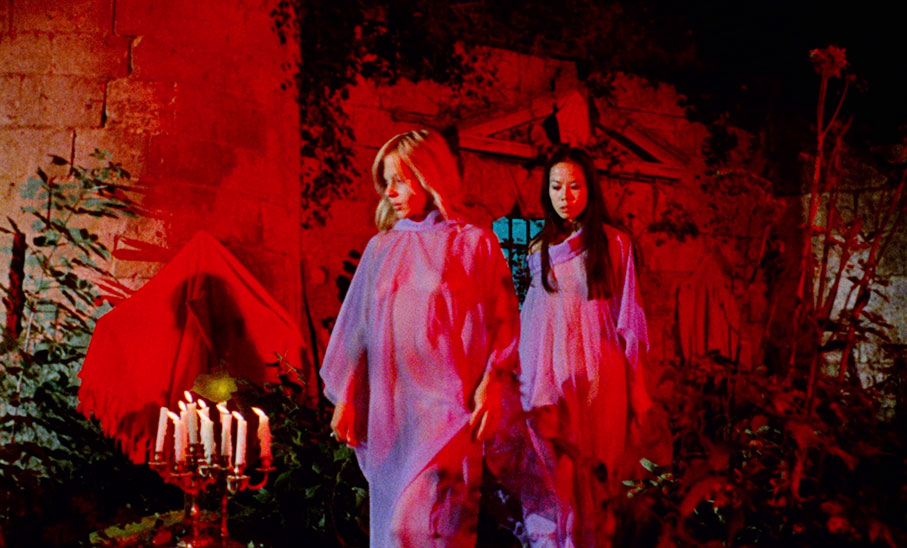
Watching the film on Blu-ray was certainly an eye-opener, with the restoration and transfer wiping the floor with previous standard definition releases. Although not an HD digital-sharp film, the detail is very nicely defined here and the contrast is attractively punchy, with deep blacks really emphasising the darkness of night. The real star of the show, however, is the reproduction of the colour lighting effects, which has a richness and vibrancy that really pops off the screen, but without a hint of the bleed or oversaturation that you sometimes saw back in SD video days. Framed in its original aspect ratio of 1.66:1, the image has been completely stabilised in frame and just about every instance of dust and dirt has been cleaned away. A fine film grain is visible, and the booklet makes a point of stating that, “No grain management, edge enhancement or sharpening tools were employed to artificially alter the image in any way.” Excellent. But wait, there’s more.
All the positives of the Blu-ray also go for the 4K UHD edition, but comparing them side-by-side reveals some subtle but pleasing improvements to the image. Although not significantly sharper – given the look of the film, this did not surprise me – the fine detail is often just a little more clearly defined, particularly on close-ups of faces, objects or textures. What really marks the UHD version apart, however, is the Dolby Vision HDR. It’s worth noting that the image is slightly darker here than on the Blu-ray, but in a way that enhances the atmosphere without impacting on the clarity, thanks to a more generous contrast range that allows for clearer shadow detail. The colour balance is also more subtly rendered here – the vibrant blues and reds are still gorgeously reproduced, but there’s a slightly warmer, more naturalistic look elsewhere, something I first noticed on the stonework of the castle walls at night in the post-title scene. The Blu-ray transfer is first-rate, but the UHD upgrade takes it to another level and is definitely the one to go for if you have the gear to play it.
Both discs feature the original French audio in Linear PCM 1.0 mono, and each of the tracks is clear and free of damage and wear, with the music and sound effects in particular reproduced with pleasing fidelity. Also included, and of similar audio quality, is the English dub that accompanied the film’s US and UK releases. As these things go, it’s not that bad, though it does conform to what would later become a movie standard by giving Isle and Antoine American accents and the vampires English ones.
Optional English subtitles automatically kick in if you elect to play the film in its original French, and optional subtitles for the deaf and hearing impaired are available for the English dub.
Audio Commentary with Jean Rollin
Recorded in 2006, presumably for a previous French or American DVD release, this commentary by Rollin is conducted in French with optional English subtitles by Powerhouse Films, and proves to be an informative and most engaging inclusion. A chatty Rollin provides revealing detail on a variety of aspects of the film and its making, including the actors, the lighting, the use of coloured gels, the sound effects, the castle fittings, the nudity, audience reaction to key moments, and much more. There’s some almost fan-boy admiration for Sandra Julien’s “perfect body,” admission that actors Michel Delahaye and Jacques Robiolles would improvise at some length because they couldn’t remember their lines, and the surprising news (because he’s rather good in the role) that Jean-Marie Durand, who plays Antoine, was not an actor but the film’s assistant director. He also relates a story in some detail about actress Nicole Nancel, who was widely disliked on set for her perceived snobbishness, but who won everyone over by insisting on being thrown into a pool of toxic moat water a second time after discovering that the camera was not running during what she did not realise was just a rehearsal.
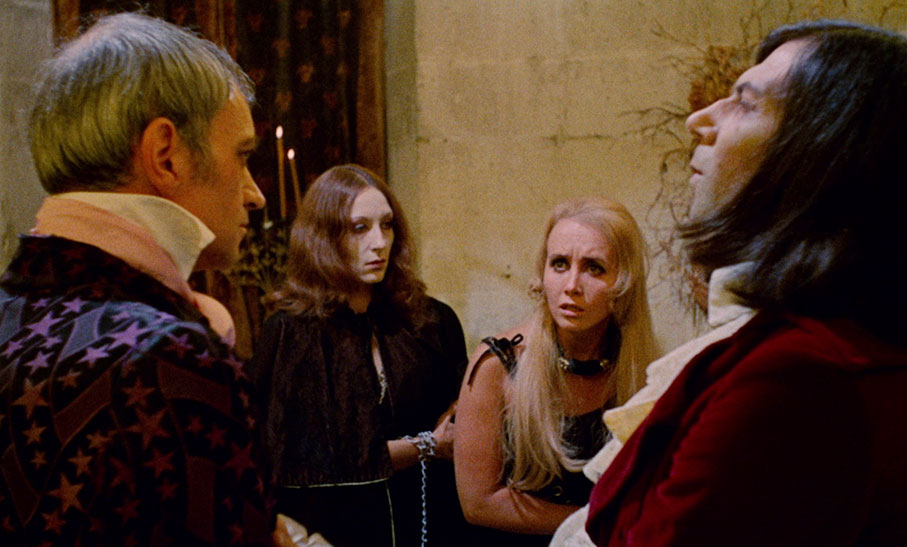
Audio Commentary with Jeremy Richey
An information-packed commentary by Jeremy Richey, author of the book Sylvia Kristel: From Emmanuel to Chabrol and creator of the long-running blog, Fascination: The Jean Rollin Experience. As you might expect from that second credit, Richey really knows his Rollin films, and The Shiver of the Vampires is one of his favourites, and his analysis is a compelling mixture of factual information and personal opinion. Areas covered include info on key cast and crew members, the pre-Goblin score by teenage rock group Acanthus, the art and film influences on Rollin and the filmmakers that he subsequently inspired, the contemporary critical disinterest in Rollin’s films and their later re-evaluation, and so much more. He regards this as one of the most important films in Rollin’s oeuvre, and makes the repeated case for the low-budget imagination and invention of filmmakers like Rollin over the overblown corporate mainstream cinema of today. “We’re badly in need of a new cinematic revolution in order to help combat the more and more bloated Hollywood productions,” is his opening cannonade in a rather inspiring call to independent cinema arms. I learned a ton from this.
Jean Rollin Introduces ‘The Shiver of the Vampires’ (4:03)
A brief introduction to the film by director Rollin, who is interviewed sitting on a sofa and, somewhat more intriguingly, reclining next to an unidentified figure hiding his or her face behind a spooky white mask. Even his interviews are tinted with surrealism. If you come to this after the Rollin commentary, as I did, then there’s little you won’t have already heard there in more detail, so it’s probably worth going to this one first.
Rouge vif: ‘Le frisson des vampires (17:17)
Billed as an updated documentary on the making of The Shiver of the Vampires by Rollin’s personal assistant, Daniel Gouyette, this featurette is built around interviews with Rollin’s long-time collaborator Jean-Noël Delamarre, and Shiver’s first assistant director Natalie Perrey. In the later stages, there is also a contribution from assistant editor Catherine Horvath, and a brief bit from director/editor Jean-Denis Bonan, from whom Horvath learned much of her craft. Initially, Delamarre does most of the talking, expanding on a story told elsewhere about staining the castle walls with fake blood, and recalling how cinematographer Jean-Jacques Renon nearly started a fight that saw them kicked out of the restaurant in which they ate their evening meals. He explains how soundproofing his father’s cellar to use as a recording studio ultimately led to them discovering the band Acanthus, and both he and Perrey back up Rollin’s story about their initial dislike of actress Nicole Nancel, and how her insistence on being thrown into a polluted moat a second time won everybody over.

Jean Rollin: Fear and Desire (40:49)
A 2004 interview with Jean Rollin by Patricia MacCormack, conducted in English but using what sounds like the on-camera microphone, which slightly impacts the clarity of the voices and adds some room reverb. Nevertheless, even saddled as I am with alarm-bell level tinnitus, I was still able to easily follow what was being said. Subjects covered include why Rollin is drawn to vampires and particularly female vampires, how seeing Universal’s House of Dracula at a young age impacted on him, the notion of using horror as a pretext for exploring interesting ideas, the influence of painting on his work, and more. I particularly liked the moment when MacCormack suggests there is a strong sense of family in his films, and Rollins sits smartly up and says to her, “You think so? Explain.” To her credit, she then makes a convincing case for her proposal.
Virginie Sélavy: Macabre Psychedelia (8:00)
Author and film historian Virginie Sélavy looks at the works that influenced The Shiver of the Vampires and the lesbian vampire subgenre that found popularity in the early 1970s. She discusses the film’s fusion of gothic, surrealism and psychedelia, and its questioning of the social order and specifically marriage, as well as paying tribute to the sequence in which Isolde emerges from the grandfather clock, which she identifies as one of the most famous scenes in Rollins’ filmography.
Export Inserts (24:17)
Additional, more sexually explicit footage shot for export versions of the film (not Britain, I’ll wager), which appear to have been sourced from a variety of media, from 35mm film to VHS. There are seven in total, which can be watched individually or in sequence using a ‘Play All’ option, the complete running time for which is noted above. Watching some of these, I was reminded of the hardcore footage shot and inserted into Tinto Brass’s 1979 Caligula by producer Bob Guccione, which featured adult film performers who were otherwise absent from film in a misguided effort to spice the movie up. Here we are introduced to a couple of sacrificial virgins, who are chained-up, whipped and tortured by two hooded figures we’re probably supposed to believe are Isle’s cousins, while more explicit lesbian fondling involving the two maids is faked by sticking wigs on two different performers and shooting them from an angle that avoids showing their faces. Interesting to see, but the film is better off without any of this.
French Theatrical Trailer (4:12)
Following a montage of thunderclap-accompanied appearances of Isolde, a somewhat ramshackle collection of shots from the film, including some potential spoilers, a generous serving of nudity, and some over-dramatic captions that promise things like “a virgin offering to the monsters” and “diabolical rituals,” but in French with optional English subtitles.
English Theatrical Trailer (4:12)
Exactly the same trailer as above, but with the English dub and the above-quoted captions changed to “a virgin attacked by monsters” and “a fiendish ritual.”
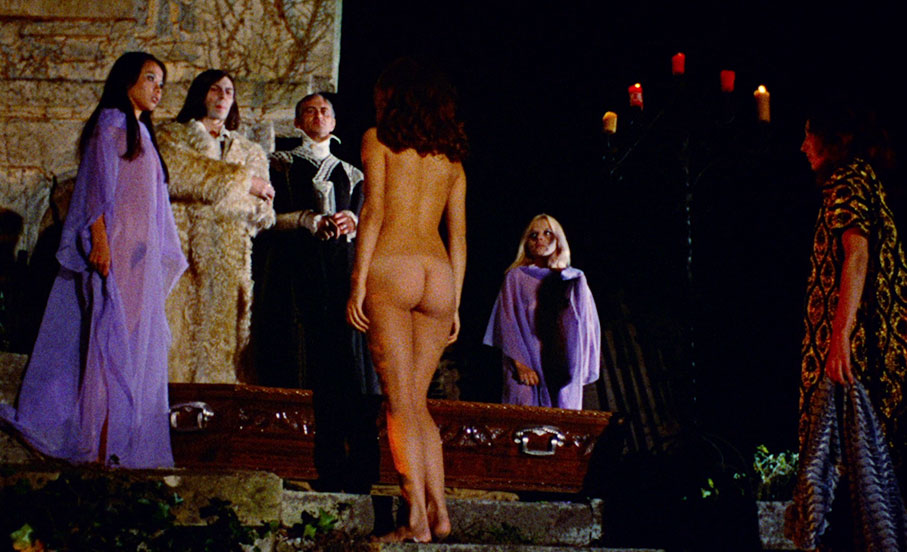
There are two Image Galleries, both of which are manually advanced. Original Promotional Material features 88 screens of monochrome and colour promotional photos, violently hand-coloured and salacious lobby cards, pages from the French press book, VHS cover sleeves, and posters. One of these has the film retitled Sex and the Vampire and teamed with the 1969 Swedish film Eva – Den utstötta, or as it’s nonsensically retitled here, Diary of a Half-Virgin. Behind the Scenes consists of 76 screens of monochrome and colour shots of the filming, including a few posed photos of the actors. Unsurprisingly, there’s quite a bit of nudity here, and Rollin is rarely seen without a pipe in his mouth.
Booklet
An 80-page delight of a booklet that opens with an essay on the film titled The World of Eternal Darkness by writer and filmmaker David Hinds, who explores what makes The Shiver of the Vampires one of Rollin’s most accomplished films, as well as providing details of its release and marketing. Sourced from liner notes that accompanied the 2006 Encore Films DVD release of the film is a lengthy essay on its making and release by Jean Rollin himself. While some of this is also covered in Rollin’s commentary, he goes into far more detail here and peppers it with anecdotes, and it’s as entertaining as it is informative. Next up is an interview with Rollin about his formative years, conducted in 1995 by Peter Blumenstock for Video Watchdog magazine, an educational piece from which I learned a great deal. This is followed by an article by Sophie Majeur from the December 1971 issue of Sex Stars System, built around an interview with actress Marie-Pierre Castel, who relates shooting scenes at night for The Shiver of the Vampires and how the local villagers were attracted to the location by the glare of the lights. Finally, Andy Votel – who is credited here as a “musician, DJ, designer, crate-digger, and noted expert in the European musical avant-garde” – looks at the career of the rock group Acanthus in all of its personnel and name-change guises. Credits for the film have been included, and the booklet is illustrated with production stills and publicity material.
Although I’ve still not seen enough Jean Rollin films to start making content comparisons and identifying running themes with the sort of authority that Jeremy Richey has in spades, I will note that I’ve yet to see a single one that I haven’t greatly liked and admired, and for me, The Shiver of the Vampires is up there with the best of them. It a stylistically bold one-of-a-kind that embraces genre tradition, then does what all good genre movies should do by bringing something completely new to the table. It does so with real style, and an empathy for the counterculture movement that dates it in a way that I can’t help but find deeply endearing. Indicator’s Blu-ray release is top-notch, but the subtle improvements on the UHD edition really bring out the richly cinematic quality of the visuals, and make for an impressive debut for this fine label on this format. Rollin fans will have probably pre-ordered this as soon as it was announced, and as someone who has become increasingly captivated by this once seriously underrated filmmaker’s work, I have no problem highly recommending it. If you’re still on Blu-ray, that disc will not disappoint, but if you’ve made the jump to UHD, that’s definitely the one to go for.
|